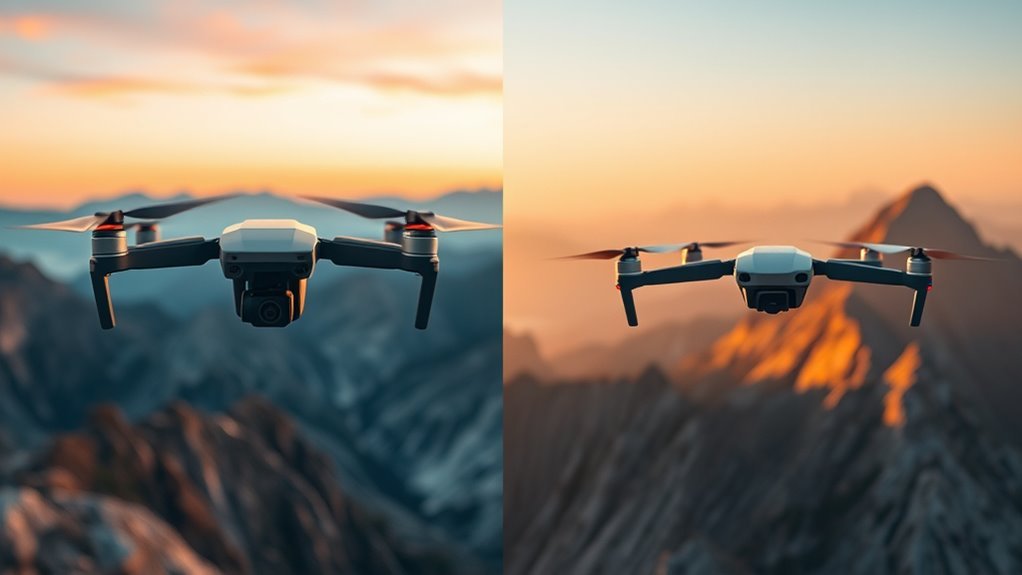When you’re comparing the DJI Mavic 3 and Autel EVO Lite for video quality, you’ll see the Mavic 3 delivers up to 5.1K at 50fps with superior low-light handling and stable performance in dynamic shots. It’s the EVO Lite’s edge in 6K resolution and 60fps that shines for high-speed action. These contrasts highlight each drone’s strengths, opening up further insights into their capabilities.
Video Resolution Comparison
When comparing the video resolutions of the DJI Mavic 3 and Autel EVO Lite, you’ll find the Mavic 3 captures up to 5.1K at 50fps with its Hasselblad camera, delivering sharp, detailed footage for dynamic scenes. In contrast, the Autel EVO Lite offers resolution formats up to 6K, giving you more flexibility to choose higher pixel counts for expansive shots that liberate your creative vision. Both drones support various resolution formats like 4K and 5.1K, but the Mavic 3 edges out with superior color accuracy from its sensor.
Regarding compression techniques, the Mavic 3 employs H.265 for efficient data reduction, minimizing file sizes while preserving detail, which frees up storage for longer flights. The Autel EVO Lite uses H.264 alongside H.265 options, providing a balance that suits different editing workflows without compromising quality. Ultimately, these choices empower you to select the best format for your aerial pursuits, ensuring ideal performance and freedom in post-production.
Frame Rates Analysis
While the DJI Mavic 3 achieves up to 50fps at 5.1K resolution, delivering smooth motion for fast-paced scenes, the Autel EVO Lite pushes further with options up to 60fps in 4K, giving you greater flexibility to capture fluid, high-speed footage without sacrificing detail. When you’re exploring frame rate advantages, the EVO Lite’s higher fps enhances cinematic effects, letting you create more dynamic, liberating sequences that feel alive and unrestricted.
To break it down objectively, here’s a comparison table highlighting key aspects:
| Aspect | DJI Mavic 3 | Autel EVO Lite |
|---|---|---|
| Resolution | Up to 5.1K | Up to 4K |
| Max Frame Rate | 50fps | 60fps |
| Frame Advantages | Smooth for standard | Greater for action |
| Cinematic Effects | Balanced motion | Fluid, immersive |
| Flexibility | Limited high-fps | Enhanced options |
This empowers you to select based on your desire for freedom in capturing vibrant, high-speed visuals.
Stabilization and Low-Light Performance
Beyond frame rates, the DJI Mavic 3’s gimbal-based stabilization delivers precise image control for steady footage, while the Autel EVO Lite’s system counters vibrations effectively, offering comparable steadiness in dynamic shots. You’ll appreciate how the Mavic 3’s superior gimbal performance minimizes shakes during fast maneuvers, giving you the freedom to explore without worrying about jittery results. In contrast, the EVO Lite’s gimbal performance holds up well in everyday scenarios, though it might show slight edges in controlled environments.
When it comes to low-light performance, sensor size plays a pivotal role. The DJI Mavic 3 boasts a larger sensor, enabling better light capture and reduced noise in dim conditions, so you can film freely at dusk or dawn. Meanwhile, the Autel EVO Lite’s smaller sensor performs adequately but struggles more with graininess, potentially limiting your nocturnal adventures. Overall, both drones empower your aerial pursuits, yet the Mavic 3 edges out for uncompromising quality in challenging lighting. (148 words)
Frequently Asked Questions
How Long Is the Battery Life for Each Drone?
You’re asking about battery life for drones like the DJI Mavic 3 and Autel EVO Lite. You’ll find the DJI Mavic 3’s battery performance delivers up to 46 minutes of flight time, while the Autel EVO Lite offers around 40 minutes, giving you more freedom in the air. For charging time, it’s about 1.5 hours for the DJI and roughly 1.6 hours for the Autel, so you’re back up quickly for extended adventures. Compare these for your needs.
What Is the Price Difference Between Them?
You’re exploring the price difference between the DJI Mavic 3 and Autel EVO Lite, which impacts your value comparison. The DJI Mavic 3 typically costs around $2,000, while the Autel EVO Lite is priced at about $600, creating a roughly $1,400 gap. When evaluating price features like camera capabilities and flight time, you’ll find the Autel offers solid value for budget-conscious flyers seeking freedom in aerial adventures without breaking the bank. It’s all about balancing cost with performance to match your needs.
Which Drone Has a Longer Flight Time?
Oh, you’re chasing that ultimate freedom in the skies, aren’t you? Who knew debating flight times could feel like a satirical quest for eternal flight? When it comes to battery efficiency, the DJI Mavic 3 outshines the Autel EVO Lite, delivering up to 46 minutes compared to 40, thanks to better flight stability that minimizes energy waste. You’ll enjoy longer, steadier adventures overhead.
Is One More Portable Than the Other?
When you’re wondering if one drone is more portable than the other, design differences and weight comparison play key roles. The DJI Mavic 3’s compact, foldable design and 895g weight make it highly packable, offering you greater freedom for on-the-go adventures. In contrast, the Autel EVO Lite’s 371g frame enhances portability further, allowing easier transport without sacrificing stability. You’ll appreciate how these factors let you explore unbound.
What Is the Maximum Flight Range?
When you’re exploring the maximum flight range of drones, transmission technology and flight stability are key factors that enhance your freedom to roam. The DJI Mavic 3 boasts up to 15 km with its advanced O3+ transmission, offering superior stability in windy conditions for reliable long-distance flights. Comparatively, the Autel EVO Lite reaches around 12 km via SkyLink technology, maintaining steady performance to let you venture boldly yet safely.

